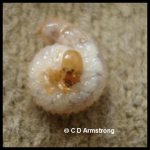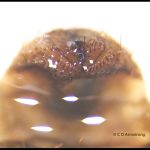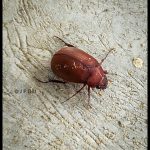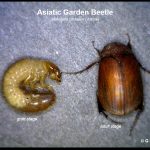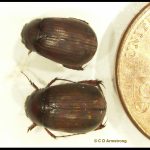Asiatic Garden Beetle
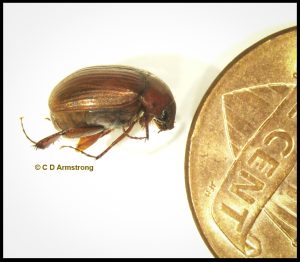
The Asiatic Garden Beetle [Maladera castanea (Arrow)] (now named Maladera formosae) is a scarab beetle pest that was first found in the United States in New Jersey, in 1922, having been introduced from its native China and Japan. The overwintering grubs live in the soil and feed on the roots of grasses and many other plants early in the spring. As such, they can be problematic for ornamental and garden plants, as well as crops such as blueberries, sweet potatoes, soybeans, corn and other vegetable crops. They sometimes damage turf but seem to show a preference for the roots of other/non-grass plants. In turf/lawn situations, the treatment threshold is considered to be 18 to 20 grubs per square foot. Grubs pupate in May and June and emerge as adults from late June through early July but adults can still be found here and there well beyond that period until cold temperatures set in.
The ~3/8 inch-long beetles, which are cinnamon-brown in color, are considerably smaller than the more familiar May/June beetles (adult Asiatic garden beetles are only about the size and shape of a coffee bean). The beetles feed mostly if not exclusively at night and are known to feed on more than 100 species of plants ranging from vegetables, herbs, fruits, trees and shrubs, to garden flowers including asters, dahlias, mums and roses. They are also attracted to lights at night, just like their larger relatives, so light traps can be employed to help reduce the adult populations.
- Asiatic Garden Beetle grub (Note: Correct ID requires careful examination of the grub’s rastral pattern of hairs because there are many other species of “white grubs” that otherwise look very similar to one another)
- Posterior end (raster) of an Asiatic Garden Beetle grub from Northeast Harbor, ME; 4/22/2024
- Asiatic Garden Beetle (Maladera formosae) (7/22/2024)
- Asiatic Garden Beetle (grub and adult)
- Asiatic Garden Beetles (Maladera formosae) (North Yarmouth, ME; 8/14/2022)
Additional Information:
- Asiatic Garden Beetle [pdf] (University of New Hampshire)
- Asiatic Garden Beetle (NC State Extension)
- White Grubs

